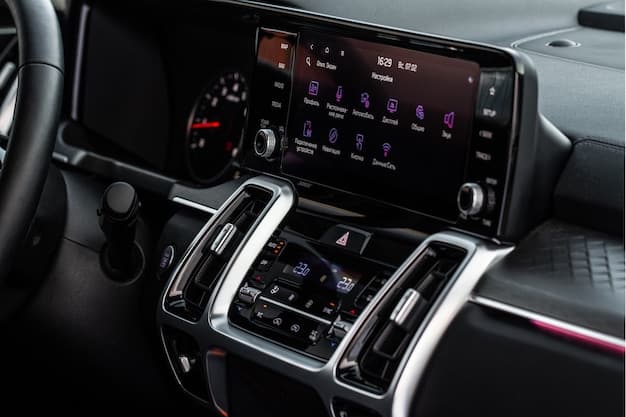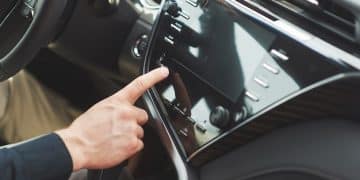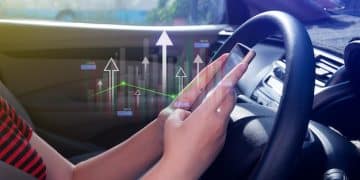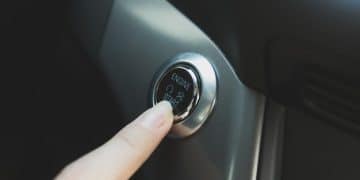Gesture Control in Cars: Gimmick or Genuine Safety Feature?

Gesture control in cars aims to enhance safety and convenience by allowing drivers to manage various functions with hand movements, but its effectiveness and necessity are debated.
Is gesture control in cars a futuristic leap towards enhanced safety, or just another gimmick vying for attention on your dashboard? Let’s explore whether this technology is a genuine advancement or merely a fleeting trend.
Understanding Gesture Control in Automotive Technology
Gesture control in automotive technology refers to the ability to operate various functions within a vehicle using hand movements recognized by sensors. These functions can include adjusting the volume, answering calls, navigating menus, and controlling climate settings.
How Gesture Control Works
Gesture control systems typically use cameras or infrared sensors to detect and interpret hand movements. The system is programmed to recognize specific gestures and associate them with corresponding functions. When a driver makes a recognized gesture, the system executes the associated command.
Evolution of Gesture Control in Cars
The concept of gesture control has been around for some time, but its application in the automotive industry is relatively recent. Early systems were often clunky and unreliable, but advancements in sensor technology and software algorithms have led to more sophisticated and accurate systems. Automakers have gradually introduced gesture control as a premium feature, aiming to enhance the driving experience and set their vehicles apart.
Gesture control is being presented as an innovative feature in modern vehicles, but is it really adding value? Or is it more likely a gimmick that doesn’t really make a difference in the driving experience?

The Perceived Benefits of Gesture Control
Automakers promote gesture control as a way to enhance safety, convenience, and the overall driving experience. They claim that it reduces driver distraction and makes accessing vehicle functions more intuitive.
Enhanced Safety
One of the main arguments for gesture control is that it can improve safety by allowing drivers to keep their eyes on the road. Instead of fumbling with knobs, buttons, or touchscreens, drivers can perform functions with simple hand movements. This reduces the amount of time the driver’s eyes are diverted from the road, potentially preventing accidents.
Increased Convenience
Gesture control is also intended to make accessing vehicle functions more convenient. For example, a driver can adjust the volume by simply twirling a finger, instead of reaching for a knob or pressing a button. This can be particularly useful in situations where the driver’s hands are already occupied, such as when gripping the steering wheel tightly during a turn.
Modernity and Luxury
Gesture control is often marketed as a premium feature that adds a touch of modernity and luxury to a vehicle. It can appeal to tech-savvy consumers who are looking for the latest and greatest in automotive technology. The presence of gesture control can also enhance the perceived value of a vehicle, making it seem more advanced and sophisticated.
- Reduced Distraction: Keep eyes on the road with simple hand movements.
- Easy Access: Quickly manage functions like volume and calls.
- Enhanced Experience: Adds a modern, high-tech feel to the car.
Many consumers view gesture control only as a selling point, a way for automakers to add features to their new products without actually increasing safety. It is important to analyze both sides of the argument to truly understand gesture control.
The Argument Against: Is It Just a Gimmick?
Despite the potential benefits, critics argue that gesture control is often more of a gimmick than a genuine safety feature. They point to issues with accuracy, reliability, and the actual reduction in driver distraction.
Accuracy and Reliability Issues
One of the main criticisms of gesture control is that it can be unreliable and inaccurate. The system may not always recognize gestures correctly, leading to unintended actions or frustration for the driver. Factors such as lighting conditions, hand size, and clothing can all affect the accuracy of gesture recognition.
The Learning Curve
Gesture control systems often require a learning curve for drivers to become proficient in using them. Drivers need to learn the specific gestures that the system recognizes and how to perform them correctly. This can be time-consuming and may not be intuitive for all drivers.
Is It Really Less Distracting?
Some studies have questioned whether gesture control actually reduces driver distraction. While it may seem intuitive to use hand gestures, drivers still need to think about what gesture to use and whether the system has recognized it correctly. This mental process can be just as distracting as reaching for a physical control.
Critics claim that gesture control is more trouble than it is worth, adding additional challenges for driver and not increasing safety at all.
Real-World Performance and User Experience
The real-world performance of gesture control systems can vary depending on the vehicle, the system implementation, and the driver’s preferences. Some users find gesture control to be a useful and convenient feature, while others find it to be frustrating and unreliable.
User Reviews and Feedback
User reviews of gesture control systems are mixed. Some users rave about the convenience and ease of use, while others complain about accuracy issues and the learning curve. Many users find that gesture control works well in some situations but not in others.
Common Complaints
Common complaints about gesture control include:
- Inconsistent Recognition: The system doesn’t always recognize gestures correctly.
- False Positives: The system misinterprets unintended hand movements as gestures.
- Limited Functionality: The system only supports a limited number of gestures.
- Complexity: The system is not intuitive and requires a learning curve.
Positive Experiences
Despite the complaints, some users have positive experiences with gesture control. They find it to be a convenient way to access vehicle functions without taking their eyes off the road. They also appreciate the modern and high-tech feel that gesture control adds to the vehicle.
Even in real world testing, some consumers find that gesture control in cars are not up to par relative to expectations. Either they don’t work properly, or the gestures they recognize are too limited.

How Gesture Control Stacks Up Against Alternatives
Gesture control is not the only technology aimed at reducing driver distraction. Other alternatives include voice control, head-up displays, and traditional physical controls.
Voice Control
Voice control is another technology that allows drivers to access vehicle functions without taking their hands off the wheel. Voice control systems have become increasingly sophisticated in recent years, with many systems now able to understand natural language commands. Many drivers find voice control to be more reliable and intuitive than gesture control.
Head-Up Displays
Head-up displays (HUDs) project important information, such as speed, navigation directions, and safety warnings, onto the windshield in front of the driver. This allows drivers to keep their eyes on the road while still being able to access important information. HUDs can be a valuable tool for reducing driver distraction.
Traditional Physical Controls
Some drivers prefer traditional physical controls, such as knobs, buttons, and switches, because they are familiar and easy to use. Physical controls provide tactile feedback, allowing drivers to operate them without looking at them. Many drivers find physical controls to be more reliable and less distracting than gesture control.
There may be much better ways to control your vehicle’s media or climate controls than gesture control in cars. It is important to always have alternatives available.
The Future of Gesture Control in Cars
Despite the criticisms, gesture control is likely to continue to evolve and improve in the coming years. Advancements in sensor technology, software algorithms, and artificial intelligence could lead to more accurate, reliable, and intuitive gesture control systems.
Advancements in Technology
Future gesture control systems may use more advanced sensors, such as 3D cameras and radar, to improve accuracy and reliability. They may also use machine learning to adapt to individual drivers’ preferences and driving styles. Additionally, the integration of augmented reality could provide visual feedback to confirm gesture recognition.
Integration with Other Technologies
Gesture control could be integrated with other technologies, such as voice control and eye-tracking, to create a more seamless and intuitive user experience. For example, a driver could use a combination of voice commands and gestures to control vehicle functions.
Wider Adoption
As gesture control technology improves and becomes more affordable, it is likely to be adopted in a wider range of vehicles, from luxury cars to more mainstream models. This could lead to a more standardized approach to gesture control, making it easier for drivers to use in different vehicles.
While gesture control may still be unrefined, it has incredible opportunity to improve in the coming years. With future technology and integration, it could truly be considered a modern safety feature.
Conclusion: Is Gesture Control a Worthwhile Feature?
Whether gesture control in cars is a gimmick or a genuine safety feature is a matter of perspective. While it offers the potential to enhance safety and convenience, it also has limitations and drawbacks. Ultimately, its value depends on the individual driver’s preferences and experiences. As technology advances, gesture control may become more refined and reliable, but for now, it remains a feature with both promise and challenges.
| Key Point | Brief Description |
|---|---|
| 👍 Enhanced Safety | Reduces driver distraction by allowing hands-free control. |
| 👋 Convenience | Easy access to functions like volume and calls. |
| 🤔 Reliability Issues | Accuracy can vary based on lighting, clothing, and system quality. |
| 💰 Cost Factor | Often a premium feature, adding to the vehicle’s overall price. |
Frequently Asked Questions
▼
Gesture control allows drivers to operate vehicle functions using hand movements, detected by sensors to control features like volume, calls, and climate settings without physical contact.
▼
Gesture control aims to reduce distraction, but its effectiveness varies. Some studies question whether it’s less distracting than traditional controls, as it still requires mental processing.
▼
Yes, issues like inconsistent recognition, false positives (misinterpreting movements), and limited functionality are frequently reported by gesture control in cars users.
▼
Many find voice control more reliable than gesture control. Advanced voice systems understand natural language commands, making them potentially more intuitive and less error-prone.
▼
Future systems may use 3D cameras, radar, and machine learning to improve accuracy and adapt to individual driving styles, leading to more seamless experiences.
Conclusion
In conclusion, gesture control in cars presents a mixed bag of potential benefits and practical challenges. While it offers intriguing possibilities for enhanced safety and convenience, its real-world effectiveness is subject to ongoing debate and technological refinement. The decision to embrace this technology ultimately depends on individual driver preferences and expectations.





